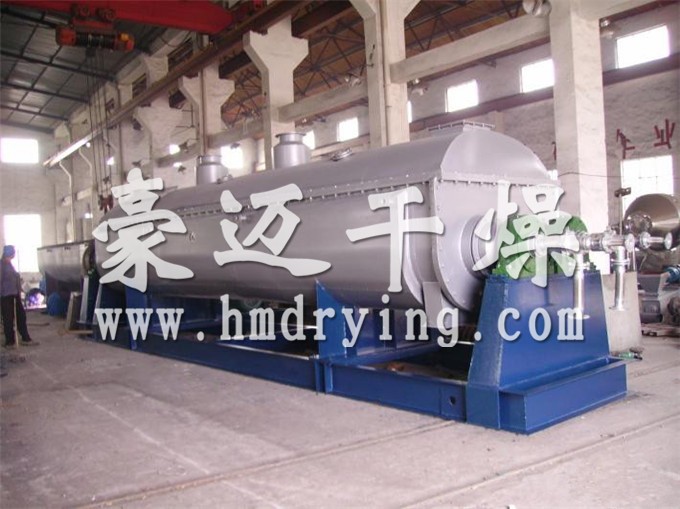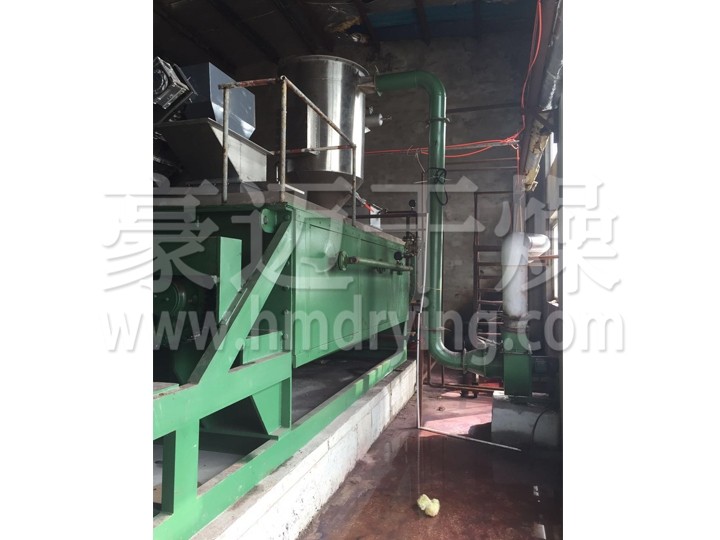Description
Special dryer for activated sludge
Key words: activated sludge dryer activated sludge drying sludge dryer sludge drying treatment sludge drying sewage treatment
Classification: slime engineering industry
Case overview: proper disposal of sludge to reduce, stabilize, harmless and recycle has become a global concern. Sludge is a by-product in the process of sewage treatment, and sludge dewatering is the key link of sludge treatment.
The rapid development of economy makes the discharge of domestic sewage and production sewage increase continuously. Sludge is a kind of solid sediment obtained from sewage treatment plant when purifying sewage. It contains solid particles such as sediment, fiber, animal and plant residues mixed with domestic sewage or industrial wastewater and their coagulated flocs. It is a complex of various colloids, organic matter, adsorbed metal elements, microorganisms, bacteria, insect eggs and other substances. Its composition is complex, its variability is large, and its organic matter content is high, It is easy to rot and stink. Therefore, if the sludge produced in the process of domestic sewage treatment is not properly treated and disposed, it will cause great damage to the surrounding environment such as water body, soil and atmosphere in the stacking area, and also cause certain harm to the health of people living around and animals living nearby. It has become a global concern to properly dispose sludge to reduce, stabilize, harmless and recycle. Sludge is a by-product in the process of wastewater treatment, and sludge dewatering is the key link of sludge treatment.
Activated sludge is composed of bacteria, protozoa and other microorganisms mixed with suspended substances and colloidal substances, which has a strong ability to adsorb and decompose organic matters. This floc structure has good settling performance, separating the treated water from the sludge, and finally achieving the purpose of wastewater purification.
At this time, the sludge will stick to the wall of the dryer, which will reduce the drying efficiency and even damage the equipment.
The sludge double blade dryer designed and manufactured by Changzhou Haomai drying Engineering Co., Ltd. can solve this problem through corresponding technical measures and design. Moreover, the sludge double paddle dryer can meet the needs of printing and dyeing, papermaking, biology, electroplating, thermoelectricity, chemical industry and sewage treatment plants. The initial moisture content of general sludge after dewatering is 80%, and the final moisture content after drying is 10% - 50%, while the industry's requirement for general sludge is about 30%. The dry sludge dried by the sludge double paddle dryer becomes loose powder particles, which can be mixed with pulverized coal and directly burned in the boiler. The calorific value of the sludge is about 1500-2000kcal, which can be used as waste and save energy. Some sludge can also be made into fertilizer and building materials after drying, or directly landfilled, which will not cause secondary pollution and turn waste into treasure. It can completely meet the requirements of environmental protection.
principle of activated sludge dryer: wedge type hollow blades are densely arranged on the hollow shaft, and the thermal medium heat transfer oil flows from the hollow axial flow to the blade, and the heat transfer area per unit effective volume is very high. The heat transfer medium flows through the rotary joint through the shell jacket and the hollow mixing shaft. The hollow mixing shaft has different internal structure according to the type of hot medium, so as to ensure good heat transfer effect. When the blade and jacket are heated by hot medium, the upper part of the outlet is dehumidified at the same time, which increases the drying strength of the machine. The evaporated water is taken out of the drying equipment by the dehumidification fan.
characteristics of activated sludge dryer: Haomai design and production of sludge double blade dryer has the advantages of low energy consumption, heat source can use steam, heat transfer oil, hot air, flue gas, etc. (evaporation of 1 kg of water consumes heat of 1.1-1.3kg steam), low power consumption, stable operation, low noise, small amount of labor and other advantages, basically full-automatic production.
Project case:
Soochow Soochow Fuel Co., Ltd. is one of the largest alkaline cationic fuel producers in the world, with an annual output of 10000 tons. It is worth noting that Soochow does not pursue economic benefits unilaterally and attaches great importance to environmental protection. It also deals with the daily output of sewage to meet the discharge standard. The heat generated in the drying process and the dried sludge are used in other production, Fully reflect the concept of circular economy and sustainable development.
Design parameters:
1, initial moisture content: ω 1 = 50%
2. Final moisture content after drying: ω 2 = 10%
3. Evaporation capacity: w water = 230kg / h
4. Yield: W yield = 500kg / h
5. Ambient temperature: t0 = 15 ℃
6. Feed temperature: θ 1 = 15 ℃
7. Inlet air temperature: T1 = 150 ℃
8. Outlet air temperature: T2 = 70 ℃
9. Temperature of product leaving drying chamber: θ 2 = 50 ℃
10. Moisture content of ambient air: D = 0.01kg water / kg dry air
11. Specific heat of absolutely dry product: CS = 0.4kcal/kg. ℃
12. Heat transfer area: 50 square meters
13. Total volume: 3.5m 3
14. Equipment size: length * width * height: 9.5m * 3.9m * 3.5m
15. Speed: 5-10rpm
Key words: activated sludge dryer activated sludge drying sludge dryer sludge drying treatment sludge drying sewage treatment
Classification: slime engineering industry
Case overview: proper disposal of sludge to reduce, stabilize, harmless and recycle has become a global concern. Sludge is a by-product in the process of sewage treatment, and sludge dewatering is the key link of sludge treatment.
The rapid development of economy makes the discharge of domestic sewage and production sewage increase continuously. Sludge is a kind of solid sediment obtained from sewage treatment plant when purifying sewage. It contains solid particles such as sediment, fiber, animal and plant residues mixed with domestic sewage or industrial wastewater and their coagulated flocs. It is a complex of various colloids, organic matter, adsorbed metal elements, microorganisms, bacteria, insect eggs and other substances. Its composition is complex, its variability is large, and its organic matter content is high, It is easy to rot and stink. Therefore, if the sludge produced in the process of domestic sewage treatment is not properly treated and disposed, it will cause great damage to the surrounding environment such as water body, soil and atmosphere in the stacking area, and also cause certain harm to the health of people living around and animals living nearby. It has become a global concern to properly dispose sludge to reduce, stabilize, harmless and recycle. Sludge is a by-product in the process of wastewater treatment, and sludge dewatering is the key link of sludge treatment.
Activated sludge is composed of bacteria, protozoa and other microorganisms mixed with suspended substances and colloidal substances, which has a strong ability to adsorb and decompose organic matters. This floc structure has good settling performance, separating the treated water from the sludge, and finally achieving the purpose of wastewater purification.
At this time, the sludge will stick to the wall of the dryer, which will reduce the drying efficiency and even damage the equipment.
The sludge double blade dryer designed and manufactured by Changzhou Haomai drying Engineering Co., Ltd. can solve this problem through corresponding technical measures and design. Moreover, the sludge double paddle dryer can meet the needs of printing and dyeing, papermaking, biology, electroplating, thermoelectricity, chemical industry and sewage treatment plants. The initial moisture content of general sludge after dewatering is 80%, and the final moisture content after drying is 10% - 50%, while the industry's requirement for general sludge is about 30%. The dry sludge dried by the sludge double paddle dryer becomes loose powder particles, which can be mixed with pulverized coal and directly burned in the boiler. The calorific value of the sludge is about 1500-2000kcal, which can be used as waste and save energy. Some sludge can also be made into fertilizer and building materials after drying, or directly landfilled, which will not cause secondary pollution and turn waste into treasure. It can completely meet the requirements of environmental protection.
principle of activated sludge dryer: wedge type hollow blades are densely arranged on the hollow shaft, and the thermal medium heat transfer oil flows from the hollow axial flow to the blade, and the heat transfer area per unit effective volume is very high. The heat transfer medium flows through the rotary joint through the shell jacket and the hollow mixing shaft. The hollow mixing shaft has different internal structure according to the type of hot medium, so as to ensure good heat transfer effect. When the blade and jacket are heated by hot medium, the upper part of the outlet is dehumidified at the same time, which increases the drying strength of the machine. The evaporated water is taken out of the drying equipment by the dehumidification fan.
characteristics of activated sludge dryer: Haomai design and production of sludge double blade dryer has the advantages of low energy consumption, heat source can use steam, heat transfer oil, hot air, flue gas, etc. (evaporation of 1 kg of water consumes heat of 1.1-1.3kg steam), low power consumption, stable operation, low noise, small amount of labor and other advantages, basically full-automatic production.
Project case:
Soochow Soochow Fuel Co., Ltd. is one of the largest alkaline cationic fuel producers in the world, with an annual output of 10000 tons. It is worth noting that Soochow does not pursue economic benefits unilaterally and attaches great importance to environmental protection. It also deals with the daily output of sewage to meet the discharge standard. The heat generated in the drying process and the dried sludge are used in other production, Fully reflect the concept of circular economy and sustainable development.
Design parameters:
1, initial moisture content: ω 1 = 50%
2. Final moisture content after drying: ω 2 = 10%
3. Evaporation capacity: w water = 230kg / h
4. Yield: W yield = 500kg / h
5. Ambient temperature: t0 = 15 ℃
6. Feed temperature: θ 1 = 15 ℃
7. Inlet air temperature: T1 = 150 ℃
8. Outlet air temperature: T2 = 70 ℃
9. Temperature of product leaving drying chamber: θ 2 = 50 ℃
10. Moisture content of ambient air: D = 0.01kg water / kg dry air
11. Specific heat of absolutely dry product: CS = 0.4kcal/kg. ℃
12. Heat transfer area: 50 square meters
13. Total volume: 3.5m 3
14. Equipment size: length * width * height: 9.5m * 3.9m * 3.5m
15. Speed: 5-10rpm









